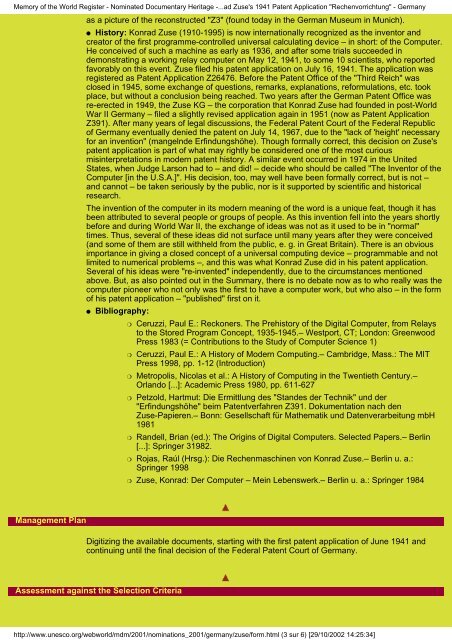Konrad Zuse's 1941 Patent Application - Unesco
Konrad Zuse's 1941 Patent Application - Unesco
Konrad Zuse's 1941 Patent Application - Unesco
Create successful ePaper yourself
Turn your PDF publications into a flip-book with our unique Google optimized e-Paper software.
Memory of the World Register - Nominated Documentary Heritage -...ad <strong>Zuse's</strong> <strong>1941</strong> <strong>Patent</strong> <strong>Application</strong> "Rechenvorrichtung" - Germany<br />
Management Plan<br />
as a picture of the reconstructed "Z3" (found today in the German Museum in Munich).<br />
● History: <strong>Konrad</strong> Zuse (1910-1995) is now internationally recognized as the inventor and<br />
creator of the first programme-controlled universal calculating device – in short: of the Computer.<br />
He conceived of such a machine as early as 1936, and after some trials succeeded in<br />
demonstrating a working relay computer on May 12, <strong>1941</strong>, to some 10 scientists, who reported<br />
favorably on this event. Zuse filed his patent application on July 16, <strong>1941</strong>. The application was<br />
registered as <strong>Patent</strong> <strong>Application</strong> Z26476. Before the <strong>Patent</strong> Office of the "Third Reich" was<br />
closed in 1945, some exchange of questions, remarks, explanations, reformulations, etc. took<br />
place, but without a conclusion being reached. Two years after the German <strong>Patent</strong> Office was<br />
re-erected in 1949, the Zuse KG – the corporation that <strong>Konrad</strong> Zuse had founded in post-World<br />
War II Germany – filed a slightly revised application again in 1951 (now as <strong>Patent</strong> <strong>Application</strong><br />
Z391). After many years of legal discussions, the Federal <strong>Patent</strong> Court of the Federal Republic<br />
of Germany eventually denied the patent on July 14, 1967, due to the "lack of 'height' necessary<br />
for an invention" (mangelnde Erfindungshöhe). Though formally correct, this decision on <strong>Zuse's</strong><br />
patent application is part of what may rightly be considered one of the most curious<br />
misinterpretations in modern patent history. A similar event occurred in 1974 in the United<br />
States, when Judge Larson had to – and did! – decide who should be called "The Inventor of the<br />
Computer [in the U.S.A.]". His decision, too, may well have been formally correct, but is not –<br />
and cannot – be taken seriously by the public, nor is it supported by scientific and historical<br />
research.<br />
The invention of the computer in its modern meaning of the word is a unique feat, though it has<br />
been attributed to several people or groups of people. As this invention fell into the years shortly<br />
before and during World War II, the exchange of ideas was not as it used to be in "normal"<br />
times. Thus, several of these ideas did not surface until many years after they were conceived<br />
(and some of them are still withheld from the public, e. g. in Great Britain). There is an obvious<br />
importance in giving a closed concept of a universal computing device – programmable and not<br />
limited to numerical problems –, and this was what <strong>Konrad</strong> Zuse did in his patent application.<br />
Several of his ideas were "re-invented" independently, due to the circumstances mentioned<br />
above. But, as also pointed out in the Summary, there is no debate now as to who really was the<br />
computer pioneer who not only was the first to have a computer work, but who also – in the form<br />
of his patent application – "published" first on it.<br />
● Bibliography:<br />
❍ Ceruzzi, Paul E.: Reckoners. The Prehistory of the Digital Computer, from Relays<br />
to the Stored Program Concept, 1935-1945.– Westport, CT; London: Greenwood<br />
Press 1983 (= Contributions to the Study of Computer Science 1)<br />
❍ Ceruzzi, Paul E.: A History of Modern Computing.– Cambridge, Mass.: The MIT<br />
Press 1998, pp. 1-12 (Introduction)<br />
❍ Metropolis, Nicolas et al.: A History of Computing in the Twentieth Century.–<br />
Orlando [...]: Academic Press 1980, pp. 611-627<br />
❍ Petzold, Hartmut: Die Ermittlung des "Standes der Technik" und der<br />
"Erfindungshöhe" beim <strong>Patent</strong>verfahren Z391. Dokumentation nach den<br />
Zuse-Papieren.– Bonn: Gesellschaft für Mathematik und Datenverarbeitung mbH<br />
1981<br />
❍ Randell, Brian (ed.): The Origins of Digital Computers. Selected Papers.– Berlin<br />
[...]: Springer 31982.<br />
❍ Rojas, Raúl (Hrsg.): Die Rechenmaschinen von <strong>Konrad</strong> Zuse.– Berlin u. a.:<br />
Springer 1998<br />
❍ Zuse, <strong>Konrad</strong>: Der Computer – Mein Lebenswerk.– Berlin u. a.: Springer 1984<br />
Digitizing the available documents, starting with the first patent application of June <strong>1941</strong> and<br />
continuing until the final decision of the Federal <strong>Patent</strong> Court of Germany.<br />
Assessment against the Selection Criteria<br />
http://www.unesco.org/webworld/mdm/2001/nominations_2001/germany/zuse/form.html (3 sur 6) [29/10/2002 14:25:34]
















